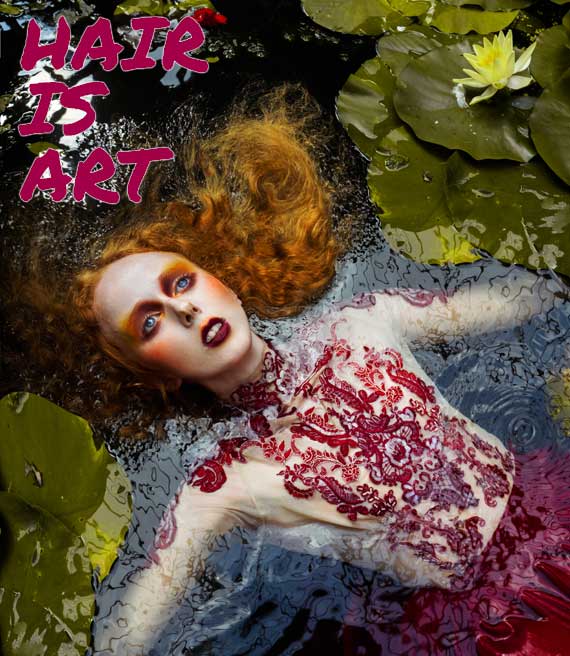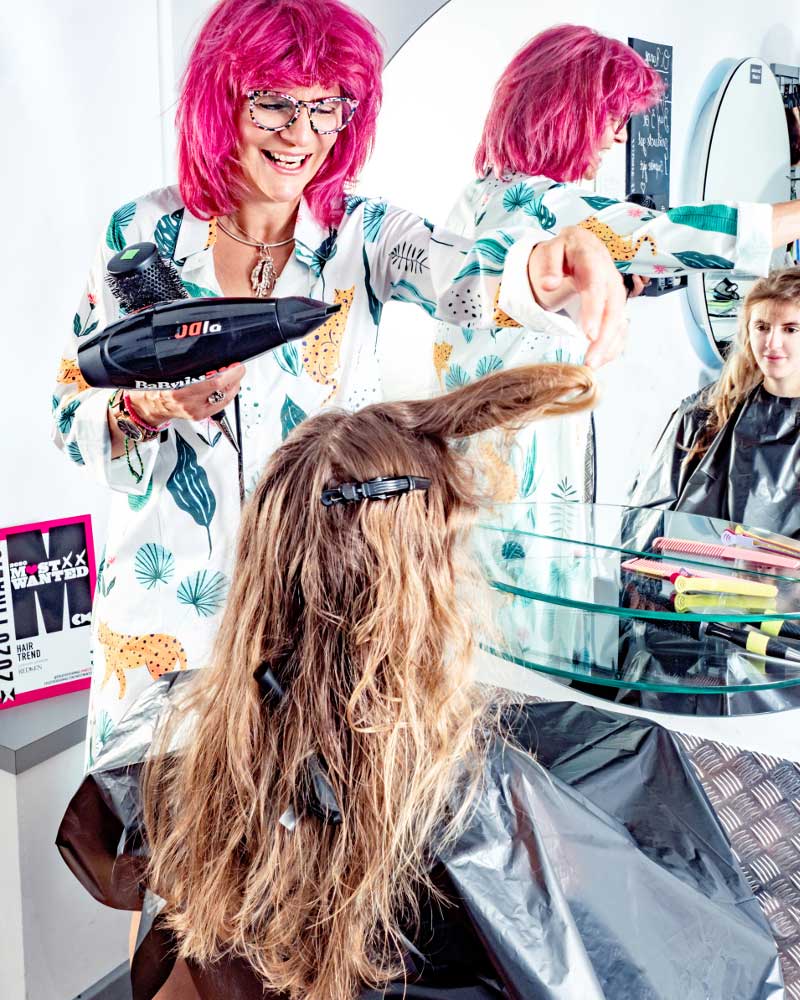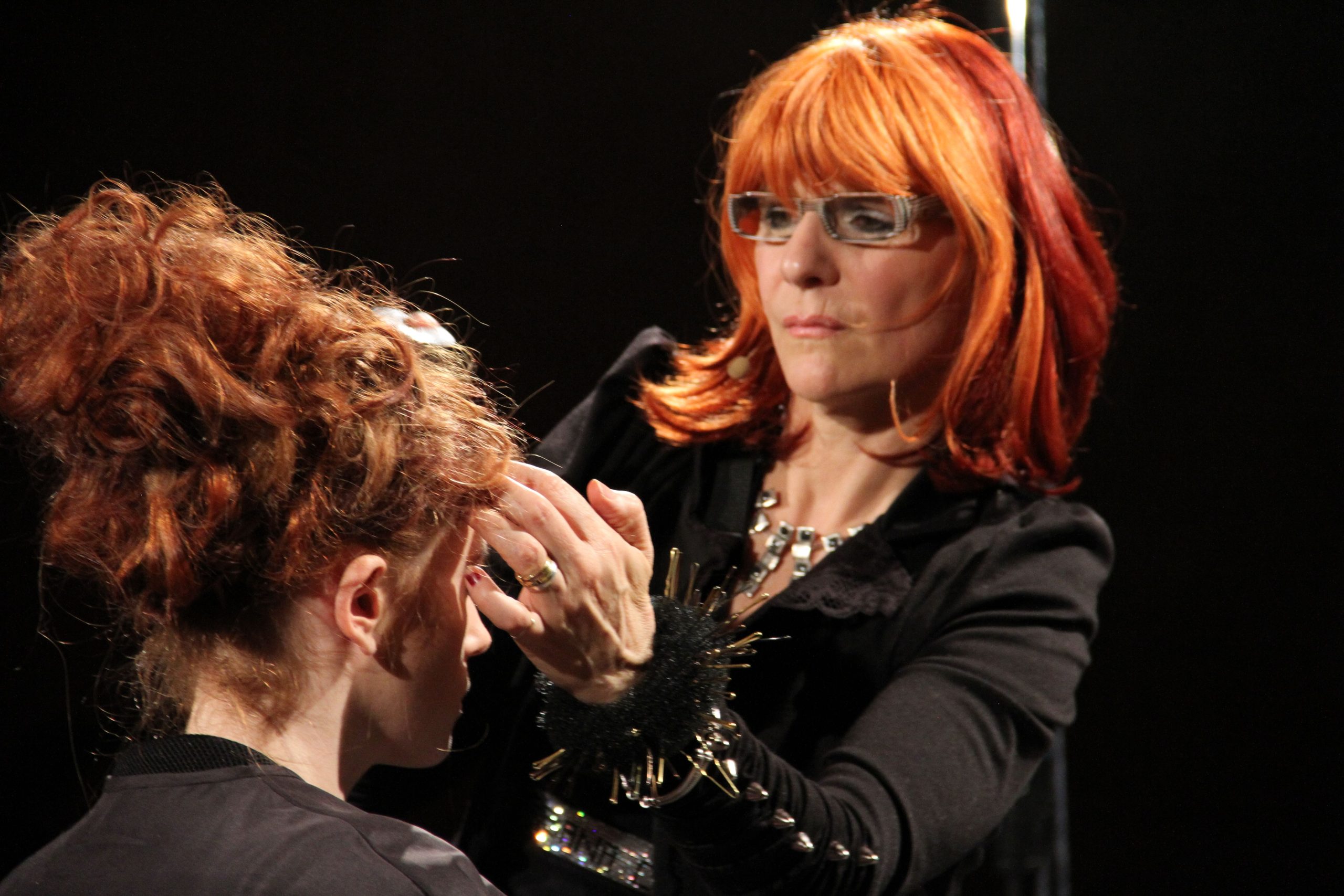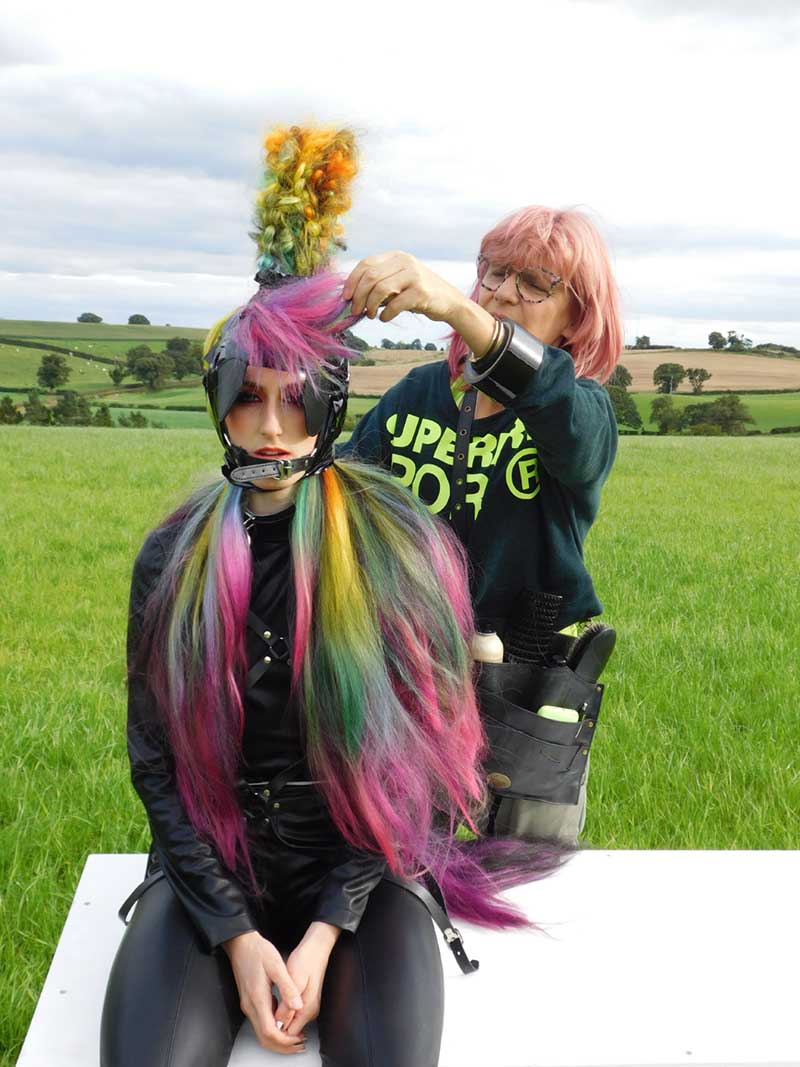It’s easy to be worried about the future. The future of hairdressing with the decrease in new apprentices coming through, the global shift to the extreme right in politics, the Russian invasion of Ukraine (who’s next if we don’t win?) and not least the breakdown of the planet’s life support system. Global heating and the destruction of nature. This latter, often termed “eco-anxiety” is enough of a thing for there to be specialist eco anxiety counsellors in our schools. So what is the best antidote to feeling helpless? The answer is ACTION. Do something.
Here we look at two responses: the first from our very own Anne Veck and the second by Grant Brown, founder of Happy Eco News.
ANNE VECK (adapted from the script of a presentation at Colour World, June 2024, in which she discusses fast fashion and eco-anxiety.)
In 2018, I created a film addressing the issue of Fast Fashion. It’s called Toxic Fashion.
The idea for this project had been in my mind for about two years. It all started after watching a program on Netflix called “The True Cost of Fashion” back in 2016. At the time I had lot’s of conflicting feelings after watching it as I am very much involved in Fashion. We all are in this room.
Fast forward and now we’re not just talking about Fast Fashion; we’re witnessing the rise of Ultra Fast Fashion.
What is UFF and what is the difference with FF. It’s the scale and speed of it. It’s a SOCIAL DISASTER.
Many hoped that the pandemic would make the fashion industry more sustainable. In reality it is the opposite. Instead of improving, the industry got worse. During lockdowns, online brands like Shein experienced explosive growth in popularity.
To put things into perspective, established brands like Gap introduce around 12,000 new designs a year, while H&M and Zara introduce about 25,000. In contrast, Shein, Temu, and Cider leave them right behind, by producing 1.3 million new designs in the same timeframe.
They don’t bother with the concept of seasonal collections. They Invent microtrends like Ballet-core, Barbie-core and even Mermaid-core. At the same time there is limited transparency or accountability around clothing supply chains and their impact on the environment and human rights.
The other aspect of these UFF is the overproduction. What happens to the clothes we throw away, sometimes practically new? What consequences do they have on the ecosystems and human right of the countries where they are taken for disposal?
I’m not here today to put these brands on trial, but more to talk about the impact it has on our emotional state. Personally, I feel like a victim of this phenomenon. The constant bombardment of ads and societal pressures has left me feeling brainwashed. Government, Big manufacturers, the corporate world, are very good at shifting the blame on to us: “consumers”.
If I buy myself a new garment Of course It makes me happy, But for 5 min, I then feel guilty, then I feel cross at myself because I gave in (I don’t need any new clothes really) then I feel real despair and frustrated at my inability to resist consumerism temptation.
I go through a whole rollercoaster of emotions and I’m sure many of us can relate to it.
And that triggers my ECO-ANXIETY!
Eco-anxiety aka climate anxiety is the worry and distress people feel about climate change and its effects on the planet and our lives. This is a very simple explanation of it. Eco-anxiety is complex, although painful and distressing, it is rational and does not imply MENTAL ILLNESSES.
Anxiety is an emotion that alerts us to danger, which prompts us to search for more information about the situation and hopefully find potential solutions.
Sometimes, I feel overwhelmed with anxiety and sadness, especially when I consider how my seemingly innocent actions, like buying new clothes, could contribute to the chaos in the world. It’s disheartening to think about the pollution of rivers, the exploitation of human beings , and the loss of biodiversity that can result from these simple actions.
On my worst days, I think of the changes I’ve made in my life since becoming aware of the fashion industry’s impact. At times, it feels like my efforts are insignificant and don’t make a difference.
So…what to do?
I have LEARNED TO SURF THE WAVE OF MY EMOTIONS. When we’re experiencing intense emotions, it can feel like we have no choice but to explode. But we can learn to regulate those emotions. Accept we will have good days and bad days. Develop a “feeling plan”!
Name your feeling. Try to be specific. I’m feeling Angry. I’m Worried. I’m Embarrassed. I feel ASHAMED. These are all legitimate emotional responses . They simply indicate you are a well-functioning person who understands the scale and impact of the challenges. Accept this feeling. Tell yourself that it’s OK to feel whatever emotion arises. Don’t feel bad about feeling bad!
Express this feeling safely.Talk about it around you, reach out to your friends, family or clients. You may find that these feelings are much more common in your circle than you previously realised, and you’re not alone.
Care for yourself.
What do you need in the moment? You might need to cry, take a walk, watch a silly video, or crawl under the covers. Have your hair done.
Be aware of climate burnout. Take a break from social media when you feel too down. Me, I go for long bike ride!
Take Action
As soon as you start to do something, bit by bit, the crisis starts to feel less like an apocalypse and more like something we can still solve.
This is an example of what I do …I try to reduce single-use plastic, I save water by taking shorter showers and turning off the tap while conditioning my hair, I buy my clothes in charity shops. I’ve drastically cut down on my consumption habits, and I closed my Amazon account. I cycle everywhere. I’ve ban the word CONVENIENT from my language.
Individual actions may seem insignificant, but collectively, they can have a substantial impact. A study by Project Drawdown found that implementing 80 existing solutions to climate change could reduce greenhouse gas emissions by 82-92% by 2050.
To recap.
Re-direct your emotional energy into something positive. In the context of hairdressing why not down load SalonRE:Source our sustainable salon tool kit. Overflowing with things to do…bit.ly/SalonReSourceUK
And remember you’re not alone.
GRANT BROWN, HAPPY ECO NEWS 1st July 2024
When I started Happy Eco News six years ago, my intention was simply to help the people close to me. I wanted to show those in my immediate circle what I had seen from working in clean technology: many good people were doing good things to help the planet, and it wasn’t over yet. A dystopian future is not predetermined.
I wanted to persuade my friends and colleagues to take action. If the activists, scientists, and clean tech people have not given up, we should not give up either. We should help and support them instead.
The Happy Eco News concept works, as evidenced by the messages from the audience. Sharing positive news can make people feel better, even if only for a few minutes. But maybe that’s not enough. How can we inspire others to take the next step? To take tangible action and do something.
Eco-anxiety is not crazy; it is a completely reasonable reaction to existential threats like global heating. We have all doom-scrolled through endless news headlines about climate change, deforestation, or plastic pollution. Scientists are now screaming to be heard while oil companies lobby, politicians pander, and the planet and people suffer. We feel alone, helpless, and afraid. The anxiety can be so crippling that it often leads to asking, “Why even bother trying?” It creates inaction when action is the very thing we need to overcome the environmental crisis.
The traditional approach to environmental awareness often relies on bombarding us with negative data. The well-meaning scientists are freaking out, painfully aware of what the data shows. Logically, highlighting the situation’s urgency should inspire people to take action, but instead, it creates a sense of powerlessness that leaves individuals unsure of where to begin. This information overload, coupled with the lack of clear action steps, fosters eco-anxiety and hinders the action it seeks to inspire.
But what if there was a way to turn that eco-anxiety into a catalyst for positive change? In my years of talking to, writing about, and sharing stories of people taking action, I have noticed a common thread.
For some reason, the action-takers feel like they have the power to make a change, have hope for the future, and are not overwhelmed by eco-anxiety. The people most in the trenches, who are working to make the future they want to see, are the ones with the most hope and optimism.
Which came first? Are the people who have hope the ones who take action, or does taking action inspire hope and reduce eco-anxiety? Time and again, I have read about or met people fed up with feeling bad who decided to do something about it.
Taking action allowed them to move beyond eco-anxiety.
In order to move beyond environmental paralysis, you have to do something about it and for the planet. If you acknowledge the fear and make a few easy changes, your anxiety will reduce to a manageable level and maybe even go away completely.
I believe that if you want to get out of the cycle of eco-anxiety inaction, three simple things will change your life: 1) Find “The Thing You Do,” 2) Find the Others, and 3) Flex Your Power.
Find “The Thing You Do“. Climate anxiety feels so overwhelming because it is huge. Thousands of things need doing, but no person can do them all. This means you must pick one that is most important to you and focus on it. Personalizing and connecting the environmental challenge to your interests, values, or passions is the key. An environmental aspect can always be woven into a love for cooking, gardening, outdoor activities, or simply a desire to live a healthier lifestyle.
For example, foodies could focus on plant-based recipes that reduce their carbon footprint, gardening enthusiasts could explore permaculture and regenerative agriculture techniques, and outdoor adventurers could get involved with conservation efforts for their favorite hiking trails or regions.
You create a stronger sense of purpose and motivation by anchoring environmental action to something you already care about. It transforms an abstract, overwhelming issue into a tangible, personal mission aligning with your interests, values, and lifestyle.
Find the Others: We are social creatures, and there’s power in numbers. Once someone has identified “The Thing They Do,” the next step is to connect with others who share that same interest or cause. This could be through local community groups, online forums, social media communities, or even starting your own grassroots movement by “putting it out there” and seeing what happens.
Seth Godin, a marketing guru who emphasizes the power of communities, has an interesting concept. His oft-repeated phrase “people like us do things like this” means that people are unconsciously driven to act in ways that solidify their membership in a particular group. It’s about shared identity and reinforcing the norms of that group. Great things can happen when the group is aligned toward something good for the planet.
Knowledge and experiences are shared within a healthy community, and camaraderie will develop. Members will find support, encouragement, and a collective voice that amplifies individual efforts.
Suddenly, you’re no longer alone; you are part of a tribe working towards a common goal.
Flex Your Power: With a strong community rallied around “The Thing They Do,” the stage is set for impactful collective action. People like us do things like this, you know. Together with the strength of many, the group can brainstorm and organize initiatives, events, or campaigns that align with their shared mission.
This could involve hosting educational workshops, organizing neighborhood clean-ups or tree-planting events, lobbying local policymakers for sustainable changes, or launching consumer awareness campaigns to influence businesses.
The power lies in leveraging the community’s diverse skills, resources, and collective influence. Perhaps one member has event planning expertise, another is a social media whiz, and another has connections with local government officials. Combining these strengths can create a formidable force for positive change.
Collective action amplifies the impact and fosters a sense of accomplishment and empowerment. As you witness tangible results from your efforts, you reinforce the belief that your actions matter and inspire yourself to take on bigger challenges.
Moreover, success stories from these communities can inspire others to join the movement and replicate similar efforts in their regions or areas of interest.
By following these three steps – personalize the cause, build a community, and empower collective action – you can transform your eco-anxiety into a powerful catalyst for change. You will be part of a passionate movement fueled by shared interests and a collective determination to create a future we want instead of what the powers give us.















